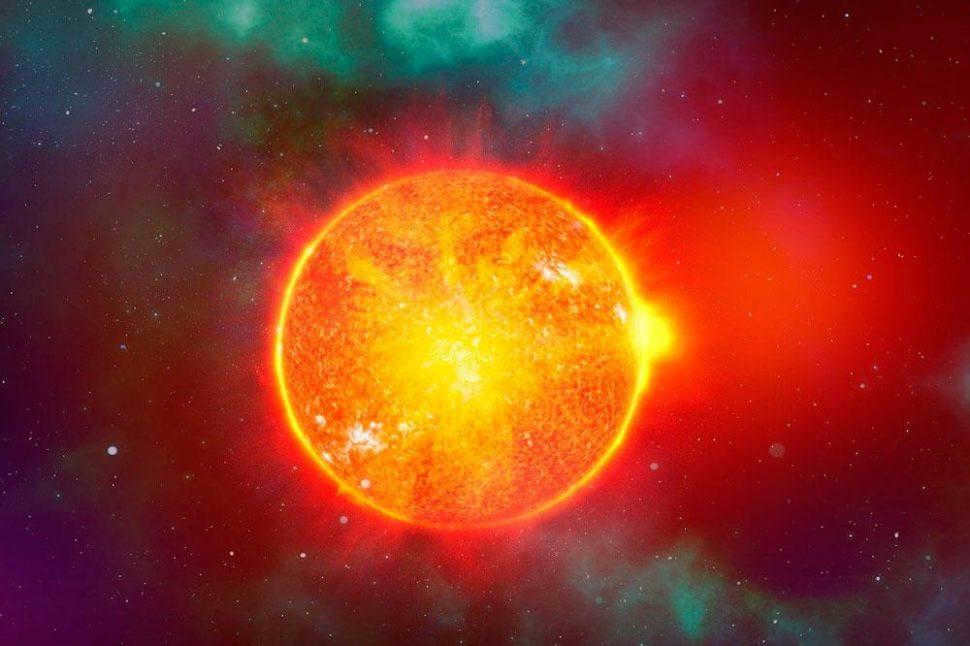
Practically all celestial bodies in the solar system undergo rotation around their central axis. This includes planets, moons, and even asteroids. However, is it possible that the Sun, being a star, also experiences rotation on its own axis?
Yes, it does, and there are several unique aspects to this rotation. Firstly, the solar axis is inclined to the ecliptic plane, which is the same plane where the orbits of the planets in the solar system are situated. This inclination measures 7.25°. Interestingly, based on the current theory of solar system formation, such an inclination should not exist because the Sun and the planets formed from a single rotating cloud of gas and dust. The reason for this deviation is still unknown to astronomers, but there is a hypothesis suggesting the presence of a massive, yet undiscovered planet on the outer fringes of the solar system. This hypothetical planet’s orbit is believed to be significantly deviated from the ecliptic plane, causing a gravitational effect on our Sun and causing it to tilt on its axis.
Furthermore, the undisclosed strata of our celestial body, beyond the reach of direct scrutiny, are whirling around the axis of our star with an even more rapid velocity. Research indicates that the central nucleus of the sun requires a mere seven days to execute a complete revolution.
When considering the tangential velocity of the sun’s rotation, it also varies across disparate regions of the star, but attains its zenith at the equatorial belt. At this juncture, the rotational speed peaks at an impressive 7,284 kilometers per hour.

What causes a star to rotate?
- A star spins around an axis due to various factors that impact its speed of rotation. These factors can originate from within the star or come from external influences.
- The trajectory of the Sun’s rotation around its axis is affected by the rotation of the planets within the system. Regardless of the size and mass of the Sun, the gravitational pull from the planets causes the axis to shift, tilt, and deviate from its original path. This resulting trajectory in space is known as the radius of center balance. The unusual tilt of the solar axis, which is influenced by the existing planets, is often attributed to the gravitational pull of a yet-to-be-discovered ninth planet. Based on the actual position of the axis, it is believed that this planet must be massive and have a significantly larger orbit than Neptune, exceeding it by more than 20 times. The influence that this hypothetical celestial body is expected to have on the Sun’s rotation around its axis indicates that its orbit must be inclined in relation to the plane containing the orbits of the other known planets in the system. In other words, the additional 6-degree tilt of the central star’s axis suggests a 30-degree inclination of the predicted planet’s orbit compared to the other orbits.
- Furthermore, the celestial body orbits around the galactic core. Alongside its accompanying planets, it circles around a singularity, which serves as the focal point of the Milky Way galaxy. Situated on the periphery of this cosmic structure, within one of its coiling arms, resides our Solar System. Each of its celestial bodies hurtle through the vast expanse of the universe, propelled by velocities surpassing one million kilometers per hour. Naturally, these phenomena have a profound impact on the rotational dynamics of our Sun.
- The rotational motion of the Sun is influenced by various factors, including its pulsation and the rhythmic expansion and contraction of its size.
What is the method used to study the rotation of the Sun?
Scientists have been using a method that dates back to the time of Galileo in order to understand whether the Sun rotates around its axis or remains in a constant and stationary state. This method involves making long observations of sunspots, which remain relatively stable over time. Despite their continuous movements, the shape and size of these sunspots remain recognizable, indicating the constant rotation of the star.
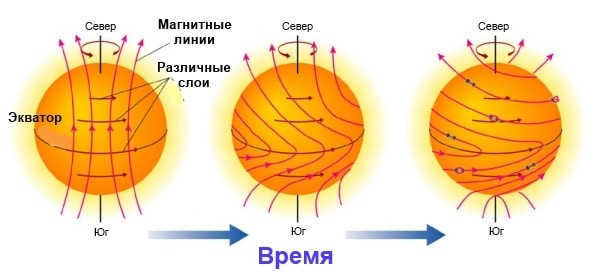
Characteristics of solar rotation
Characteristics of solar rotation
The star, which is primarily composed of hydrogen and helium, lacks the uniform density typically found in solid objects. As a result, it does not exhibit a uniform orbital velocity like solid planets such as Earth. In the equatorial region, the gases comprising the star rotate at a relatively fast pace, completing a full revolution in approximately 25 (24.74) Earth days. However, at the poles, the velocity of the matter decreases, taking about 35 days to complete a rotation. At various points in between, the rotation rate ranges from 26 to 28 days.
There is an assumption that the solar core rotates even more rapidly around its axis. Its velocity is four times higher compared to the outer layers. According to this model, it is the fast-spinning core that determines the rotational speed. The inner zones adjacent to it, the radiative transfer and convective zones, rotate slightly slower. The layers of the solar atmosphere, which include the photosphere emitting light and resembling a shining surface of the star, the chromosphere giving the luminary a reddish hue, and the corona ejecting prominences, rotate even slower.
What causes it to rotate?
Studying the current and future aspects of the star’s effect on Earth and the idiosyncrasies of its spin will undoubtedly aid scientists in unraveling numerous cosmic enigmas that abound in the universe.
Determining the Sun’s rotation is quite a complex task. It entirely depends on which specific section of the Sun is being referred to. Confused? This predicament has long perplexed astronomers. Let’s delve into the various changes in the Sun’s rotation.
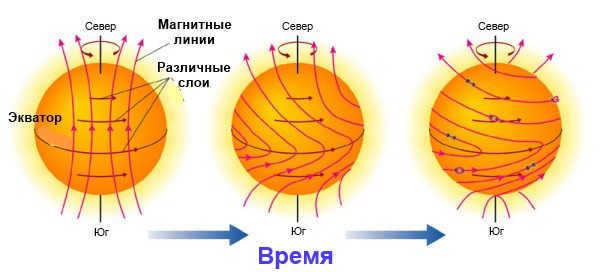

This graph visually represents the variations in the movement patterns of different layers of the Sun over time.
The time it takes for a point on the solar equator to complete one full rotation around the Sun is approximately 24.47 days. Astronomers refer to this as the sidereal rotation period, which is distinct from the Synodal period (the time it takes for a sunspot to return to its original position, facing Earth). As we approach the poles, the rate of rotation of the Sun’s axis decreases, resulting in a longer stellar rotation period of up to 38 days for polar regions.
The rotational speed of the various layers of the Sun may vary.
Therefore, scientists initiated the measurement of the velocity of the rotational axis starting from a random position at 26 degrees on the equator; this is approximately the location where the majority of sunspots are observed. At this particular point, the rotation period at the equator is 25.38 days (which represents the time it takes to complete a full revolution and return to the same position in space).
Scientists are aware that the inner portion of the Sun rotates differently compared to its surface. Initially, the core and radiation zones within the Sun undergo rotation. Eventually, the outer layers and photosphere also start rotating.
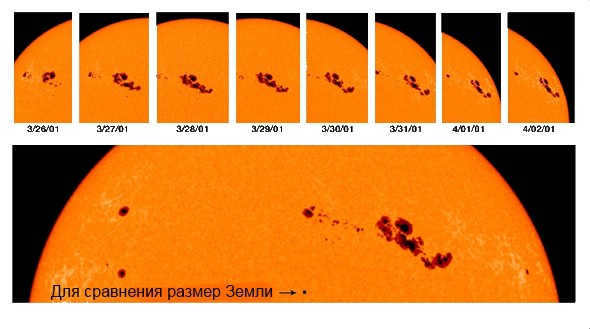
The movement of sunspots
The Milky Way is constantly rotating around its center, and our solar system is a part of this rotation. The average speed of this rotation is estimated to be around 828,000 km/h. It takes our Sun approximately 230 million years to complete one revolution around the Milky Way. The Milky Way is classified as a spiral galaxy, characterized by a central bulge, four arms, and various smaller segments. Our Sun is located in the Orion arm, which is positioned between the Perseus and Sagittarius arms. The Milky Way has a diameter of about 100,000 light years, and our solar system is situated approximately 28,000 light years away from the galactic center. Interestingly, recent theories suggest that our galaxy may actually be a barred spiral galaxy, meaning that instead of a bulge of gas and stars at the core, there is a cluster of stars intersecting the central bulge.
In summary, the solar system is constantly in motion as it rotates around the center of the Milky Way, with our Sun taking about 230 million years to complete one orbit. The Milky Way itself is a spiral galaxy with a central bulge, four arms, and smaller segments. Our Sun is located in the Orion arm, and the galaxy has a diameter of 100,000 light years, with our solar system positioned 28,000 light years away from the center. Recent hypotheses propose that our galaxy is a barred spiral galaxy, with a cluster of stars intersecting the central bulge instead of a gas and star bulge.
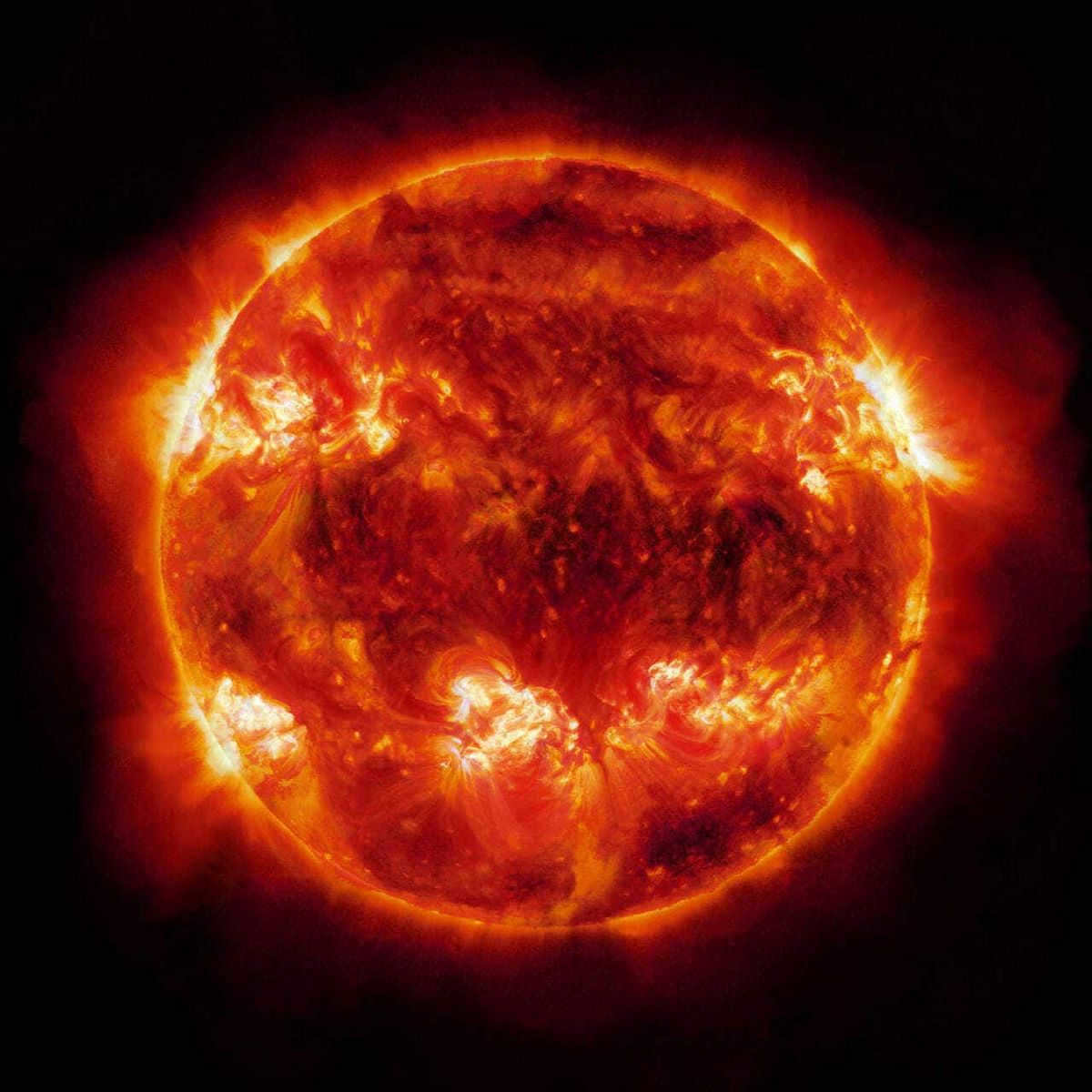
It is common knowledge that the Earth undergoes rotation on its axis, causing it to face the Sun at one point and then turn away from it. This rotation results in the alternation of day and night. Additionally, we are aware that the Earth orbits around the Sun. This annual journey takes slightly more than three hundred and sixty-five days.
The Movement of the Sun
Many people believe that the Sun remains stationary in space, a constant glowing sphere surrounded by planets. However, this is not the case. The Sun is actually in constant motion, and the planets and their moons have to work hard to keep up as it travels through space.
Here’s an interesting fact: If we could somehow weigh the Sun from Earth, we would find that its mass is an astounding 410000000000000000000000000000000000000000000000000000000000000000000000000000000000000000000000000 tons. The Sun is primarily composed of hydrogen and helium.
Firstly, the Sun does indeed rotate, much like the Earth and the other planets. Secondly, scientists believe that the Sun pulsates, expanding and contracting in size. And finally, the Sun moves through interstellar space, with the planets orbiting around it like moths drawn to a flame.
The Sun has various parts that rotate at different speeds. For instance, gases near the solar equator have a rotation period of approximately 25 days, while gases at the poles take around 33 days to complete a full rotation. On the other hand, the Earth rotates completely on its axis every 24 hours. One of the most fascinating mysteries surrounding the Sun is the behavior of its super hot core. Scientists believe that the solar core rotates four times faster than the outer layers of the Sun.
The Sun’s pulsation
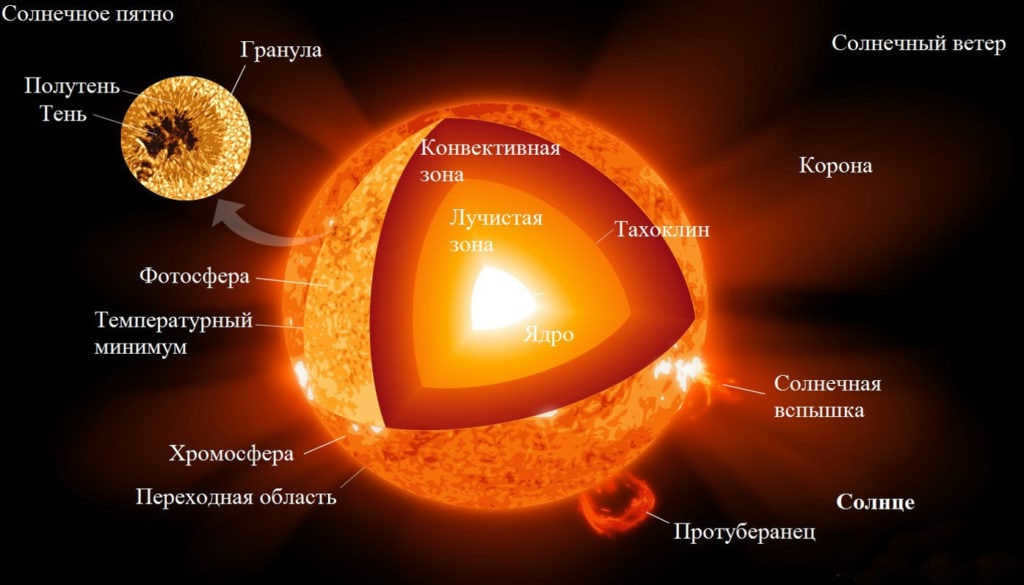
The Sun is undergoing a process of expansion and contraction, with a periodicity of five minutes. It gives the impression that our celestial body is inhaling and exhaling. The reason behind the Sun’s pulsation remains a mystery. One hypothesis suggests that the expansion and contraction are caused by the propagation of sound waves through the solar gases.
There could also be another form of solar pulsation. Scientists propose that gravity is responsible for causing the Sun to pulsate every half an hour. How does this work? Dense gases from the solar core region disperse into the less dense gases found in the surface layers of the Sun, causing a slight expansion. Subsequently, gravity pulls these dense gases back towards the center of the star, resulting in the Sun shrinking once again.
Engaging video on the fascinating Sun
If you happen to come across any inaccuracies, kindly select the specific text and press Ctrl+Enter.
What is the duration of the Sun’s rotation around its axis? – The Sun takes 27 days to complete a rotation at its equator, while at the poles the rotation period extends to 32 c.
The Sun’s axial rotation aligns with that of the Earth, occurring in a plane tilted at an angle of 82°45′ to the Earth’s orbital plane (ecliptic).
The rotation rate is determined by the apparent movement of different features on the Sun’s surface and the shift in spectral lines observed in the Sun’s edge spectrum due to the Doppler effect. Consequently, it has been established that the rotation period of the Sun varies at different latitudes.
For different latitudes φ, you can calculate the angular velocity ω of the Sun’s sidereal rotation using the following formula:
ω = 14.44 – 3-sin2φ (measured in degrees per day)
The linear speed of the Sun’s rotation at the equator is approximately 2000 m/s.
The location of various features on the Sun’s surface is determined using heliographic coordinates, which are measured from the solar equator (heliographic latitude) and from the central meridian of the visible portion of the Sun. Instead of the central meridian, an initial meridian, known as the Carrington meridian, can be used. It is conventionally assumed that the Sun rotates as a solid body. The Astronomical Yearbooks provide the position of this initial meridian for each day. Additionally, information about the position of the Sun’s axis on the celestial sphere is also available.
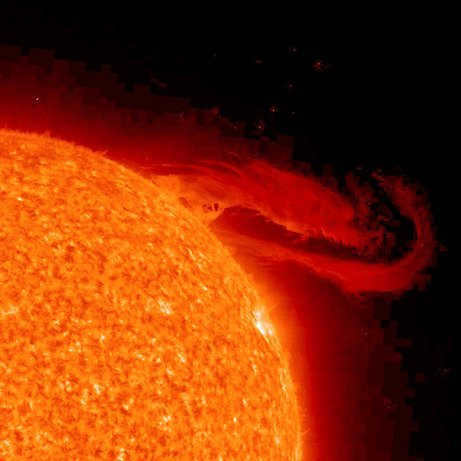
When viewed from the Earth, the measured rotation period is 24.47 days. However, if we subtract the Earth’s own rotation around the Sun, the actual rotation period is 25.38 Earth days.
This is known as the sideric rotation period in astronomy, which differs from the synodic period in terms of the time it takes for the spots to complete one rotation around the Sun as observed from Earth.
As the spots approach the poles, their rotation rate decreases, resulting in a rotation period around the axis that can reach up to 38 days at the poles.
Notable Observations of the Sun’s Rotation
The movement of the Sun can be easily observed by studying its spots, which are continually in motion across its surface. This motion is part of the Sun’s overall rotation around its axis.
Research has revealed that the Sun does not rotate as a solid body, but rather exhibits differential rotation.
This means that the Sun rotates at varying speeds, with higher velocities at its equator and slower speeds near its poles. Interestingly, this phenomenon is also observed in the gas giants Jupiter and Saturn.
Astronomers have carefully measured the Sun’s rotation rate from a latitude of 26° from the equator and determined that it completes one full revolution around its axis in approximately 25.38 Earth days. Additionally, the Sun’s axis of rotation is inclined at an angle of 7 degrees and 15 minutes.
The Sun’s movement within the Milky Way galaxy
Like a solid object, the inner regions and core of the Sun rotate in unison. However, the convective zone and photosphere, which make up the outer layers, rotate at different speeds.
The Sun’s rotation around the center of the galaxy
Our star, along with our planet, orbits around the central core of the Milky Way galaxy. The average speed of this rotation is approximately 828,000 kilometers per hour. It takes around 230 million years for one complete revolution. The Milky Way is categorized as a spiral galaxy and is thought to contain a central core and four main arms, each consisting of multiple shorter segments.
The Sun is positioned in the vicinity of the Orion arm, situated between the Perseus and Sagittarius arms, which are the two major arms of the galaxy.
It is common knowledge that the planets in our solar system, including Earth, orbit around the Sun. However, have you ever wondered if the Sun itself rotates around its own axis? And if it does, does its rotation follow the same principles as smaller celestial bodies?
How long does it take for the Sun to complete one rotation around its axis?
The answer to the first part of the question is affirmative – the Sun does indeed rotate around its own axis. It takes approximately 25 Earth days for the Sun to complete one full rotation. In terms of speed, the Sun rotates at a rate of about 7200 km/h, which is roughly four times faster than the Earth’s rotation. Now, let’s dive deeper into the answer to the second part of the question.
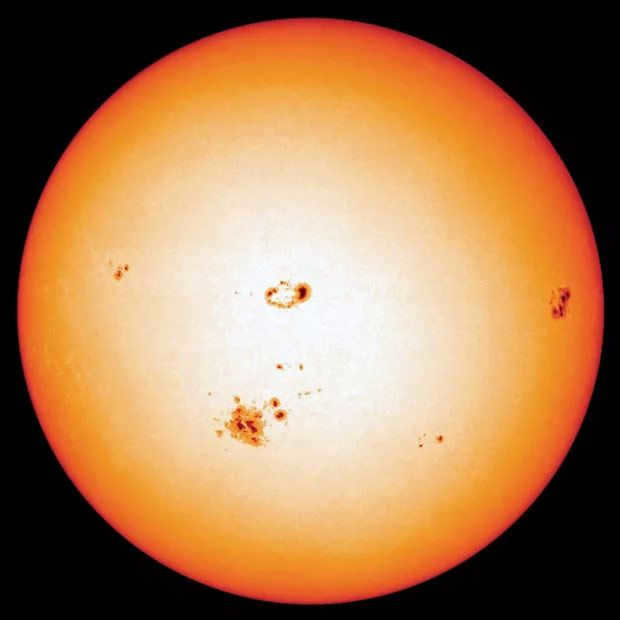

The existence of sunspots enables us to measure the speed at which the Sun rotates around its axis and the current tilt of its rotation axis.
The rotation of the Sun around its axis is not uniform, as it varies across different latitudes. The equatorial regions of the Sun complete a full revolution at a faster rate compared to the middle latitudes. This is evident from the fact that the movement of sunspots near the equator is noticeably ahead of the spots located closer to the poles. A similar phenomenon is observed in gas giant planets like Jupiter and Saturn.
Determining the orientation of the Sun’s rotational axis is a relatively straightforward task. If the axis were perpendicular to the Earth’s orbital plane, it would appear that sunspots move in straight lines across the surface of the Sun.
However, in reality, sunspots follow curved paths for most of the year, with the greatest curvature observed around March 7th and September 8th. Only on June 6th and December 6th do they move in straight lines. By accurately measuring these curvatures, we can deduce that the Sun’s axis is tilted about 7 degrees relative to the Earth’s orbital plane.
Consequently, from June to December, we observe the Sun’s north pole, while during the latter half of the year, we see the south pole of the Sun.
Therefore, by simply observing groups of sunspots on the surface of our home star, we can gather basic information about its rotation.
Does the Sun have a spherical shape or is it flattened at the poles?
We are aware that the Earth is not a perfect sphere due to its rotation, causing it to be somewhat “flattened” at the poles. The centrifugal force generated during rotation results in the Earth’s polar diameter being 43 km smaller than its equatorial diameter. Can a similar effect be observed on the Sun?
Answering this question is challenging since any deviation from the spherical shape of the Sun would be minuscule. Furthermore, detecting such a deviation is incredibly difficult.
The reality is that the light emitted from the lower boundary of the solar disk must traverse a slightly longer distance through the Earth’s atmosphere compared to that from the upper boundary. This discrepancy in the traveled path, no matter how small, presents challenges in accurately accounting for the resulting errors.
We firmly believe that some degree of flattening occurs at the Sun’s poles; however, novel observation techniques will be necessary to determine the extent of this phenomenon.
Measuring the Sun’s equatorial diameter proves to be considerably more straightforward than measuring its polar diameter. During noon, the eastern and western boundaries of the Sun share the same altitude above the horizon. Consequently, the path of light rays through the Earth’s atmosphere remains essentially uniform.
This phenomenon, known as irradiance, can result in an inaccuracy of up to 0.1%. Considering that the Sun’s diameter is 109 times that of Earth, the margin of error would be in the hundreds of kilometers!
The Sun, which is the nearest star to our planet, is also responsible for sustaining life on Earth. In the early stages of civilization, many cultures worshipped the Sun as the supreme deity, with all other gods being subordinate to it. Interestingly, various myths from different societies elucidated the origin and significance of the Sun in their own unique ways. However, in the 21st century, astronomy has provided us with a much deeper understanding of the Sun than ancient folklore ever could. Consequently, this article aims to explore the inner workings of the Sun and, more importantly, shed light on its fate millions of years from now.
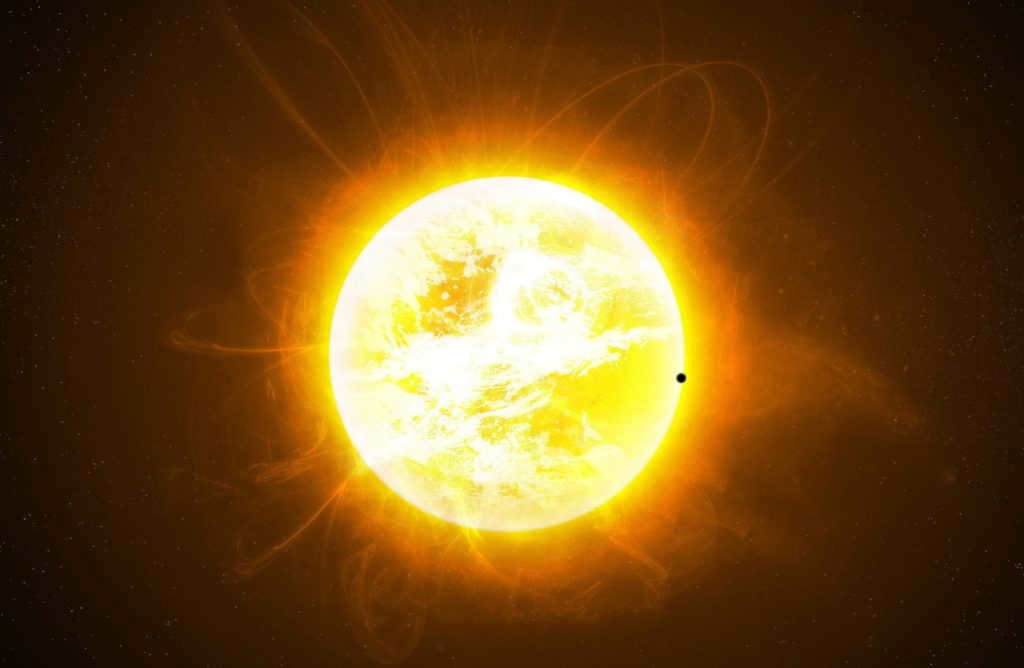
Key features
To comprehend the Sun’s position amongst other comparable celestial bodies, it is crucial to understand its general characteristics. The Sun, an enormous sphere of gas, is subjected to unbelievably high temperatures. Its diameter stretches to an astounding 1,392,700 kilometers, a staggering 109 times larger than that of our planet. The Sun’s mass is equally impressive, weighing in at approximately two nonnillion kilograms (1.98⋅1030 kg), a whopping 332,946 times heavier than Earth. Interestingly, all planets, satellites, asteroids, comets, interplanetary gas, and dust in the solar system only contribute to a mere 0.13% of the Sun’s total mass. The Sun’s density slightly surpasses that of water at 1.4 g/cm3.
The Sun is commonly observed as a yellow disk, but its true color is actually white. However, when viewed from the Earth’s surface, the Sun appears yellow due to atmospheric scattering and the absorption of certain wavelengths of light.
Within the Milky Way, there are numerous stars similar to the Sun, numbering in the hundreds of billions. The closest star to our planet is Proxima Centauri, which is located over four light-years away, equivalent to approximately 40 trillion kilometers.
If Betelgeuse were to be placed within a diagram of the solar system, its size would extend out to the orbit of Jupiter.
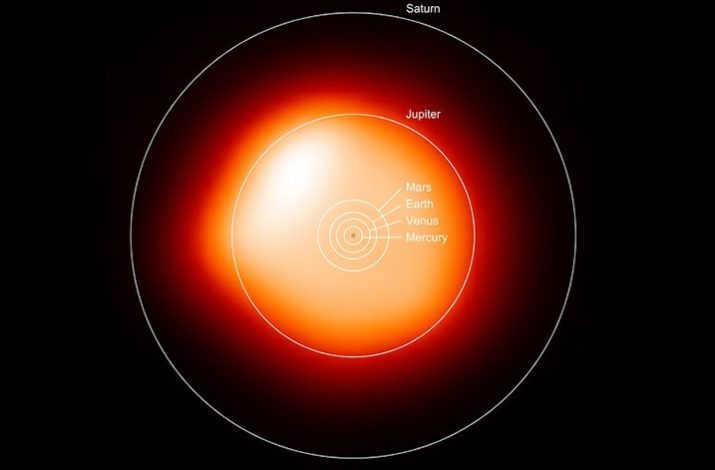
The average distance from Earth to the Sun is around 150 million kilometers, which is equivalent to one astronomical unit. From the perspective of an observer on Earth’s surface, the Sun has a visible angular diameter slightly larger than half a degree. It is positioned approximately 26 thousand light years away from the center of the Milky Way galaxy. The Sun rotates around the galaxy’s center at a speed of 230 kilometers per second.
The Sun’s heat and light are generated through thermonuclear reactions. These reactions involve the fusion of four protons to form one helium atom and release energy. Other reactions take place within the Sun’s interior, resulting in the creation of metal atoms, among other things.
Within a range of approximately 150 astronomical units, the dominant force in space is known as the solar wind.
The Sun undergoes rotational movement, but it is not consistent throughout its surface. Specifically, at the equatorial region, the star completes one full rotation in a span of 25 days, whereas at the polar regions, this process takes approximately 34 days.
Chart of the primary physical attributes of the Sun
| Value | Main characteristics |
| Diameter of the Sun in kilometers | 1 million 392 thousand |
| Equator length | 4.37 million kilometers |
| Mass | approximately 2-1027 tons |
| Surface area | 6 trillion square kilometers |
| Volume of the Sun | 1.41-1018 km³ |
| Surface temperature | 6000 °C |
| Temperature at the center of the Sun | 15 700 000 °C |
| Equatorial period of rotation around the axis | 25 days |
| Rotation period around the axis at the poles | 34 days |
| Tilt of the rotation axis to the ecliptic | 7,25° |
| Shortest distance to the Earth (perihelion) | 147.098 million kilometers |
| Greatest distance to the Earth (aphelion) | 152.098 million kilometers |
| Second space velocity | 617 km/s |
| Free-fall acceleration | 274 m/s² |
| Radiation power | 3.828-10²⁶ watts |
Composition of the Sun
Structure of the Sun
It is a misconception to believe that the Sun is composed of a single heated substance. The Sun’s structure is rather intricate, consisting of six distinct layers. Three of these layers make up the internal composition, while the remaining three constitute the so-called atmosphere. Let’s delve deeper into the components that make up the Sun.
Structure of the Sun’s Interior
For many years, astronomers were puzzled by the internal composition of the Sun. It wasn’t until the 20th century that this mystery was finally unraveled. The Sun is composed of various layers, each with its own unique characteristics.
At the center of the Sun lies its core, where nuclear fusion reactions occur. The core has a radius of approximately 150,000 kilometers.
The temperature within the Sun’s core reaches an astonishing 15 million degrees Kelvin, while the pressure exceeds 300 billion atmospheres (over 30,000 trillion Pa). Consequently, the density of the solar core is a staggering 150 kg/cm3, which is 6.67 times greater than that of the heaviest metal found on Earth, osmium.
These parameters are perfect for nuclear fusion reactions, which are responsible for generating the energy needed to sustain all life on our planet. The other regions of the Sun, although they have high temperatures, do not generate this energy themselves but rather receive it from the core.
The region of radiant transfer
This area is also known as the radiation zone and is located directly above the core. The outer boundary of the radiation zone has a radius of 490,000 kilometers. As you move away from the core, the temperature gradually decreases to 2 million degrees Celsius. This decrease in temperature also leads to a decrease in pressure, resulting in a solar matter density of 0.2 g/cm3. Unlike other regions, there is no convection transport in this zone.
The convective transport zone
The convective zone has a thickness of approximately 200,000 kilometers. The density of matter in this region is already quite low, and it is actively in motion. This means that heated matter rises rapidly upwards, releases heat, cools down, and then sinks back down. The speed of convection can reach up to 6 kilometers per hour. These processes play a crucial role in the creation of the solar magnetic field.
On the surface, the temperature of the Sun reaches an impressive 6,000 degrees, but the density is about 1,000 times lower than that of the Earth’s atmosphere.
The surface of the Sun is not uniform and contains areas of lower brightness known as sunspots. These spots can last for a few days. Interestingly, some sunspots can be larger than the diameter of the Earth itself. Additionally, the surface of the Sun also features:
- Faculae are objects that have a higher level of brightness.
- Granules are areas that cover the photosphere and can be distinguished from the Earth.
- Supergranules are large objects (approximately 35 thousand kilometers in size) that envelop the surface of the Sun.
Modern studies indicate that convective transports play a crucial role. All kinds of movements of solar matter occur in the convective zone.
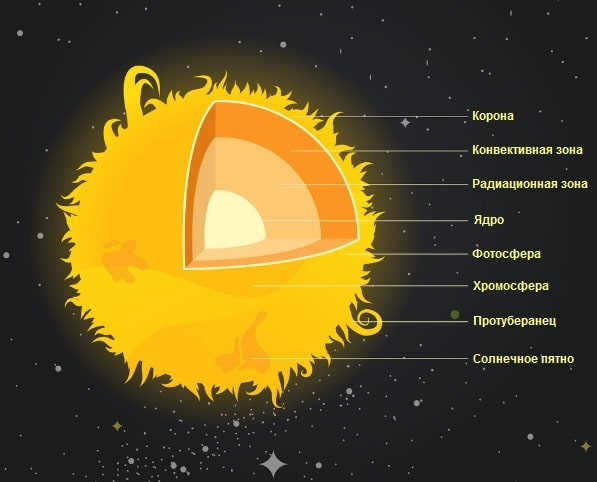
Structure of the Sun’s Atmosphere
When discussing the composition of the Sun’s atmosphere, it is generally divided into three layers: the photosphere, the chromosphere, and the corona.
Photosphere
The photosphere is the outermost layer of the Sun’s atmosphere. This is the part that is visible from Earth, as it emits light and heat that radiate to all objects in the solar system. The thickness of this section of the atmosphere measures up to 400 kilometers.
Most of the radiation that reaches the Earth comes from the photosphere, which is the outer radiating surface of the Sun. However, rays from the deeper layers of the Sun do not reach us. The temperature of the photosphere gradually decreases from 6000 Kelvin to 4400 Kelvin. The effective temperature of the photosphere is determined using the Stefan-Boltzmann law, which states that the power of radiation emitted by a perfectly black body is directly proportional to the fourth power of its temperature.
The photosphere, which is the visible surface of the Sun, provides valuable information about the size and other characteristics of our daytime star.
The solar chromosphere is positioned above the photosphere and measures approximately 2 thousand kilometers in thickness. Due to its low brightness, it is challenging to observe from Earth. However, during a solar eclipse, the chromosphere becomes visible and emits a red glow.
Within the chromosphere, there are plasma columns known as spicules, which are expelled from lower layers. These columns can extend up to 20 thousand kilometers in length. As the altitude rises, the temperature of the chromosphere also increases, reaching 20 thousand degrees at its upper boundary.
The sun’s outer atmosphere
The corona is the outermost layer of the sun’s atmosphere, and its boundaries are not clearly defined. It is composed of incredibly thin matter and has extremely high temperatures, reaching several million degrees. In certain areas, the temperature can even reach a scorching 20 million degrees Celsius.
The corona can only be seen during a total eclipse, as its substance is so thinly spread that it does not emit much light. The shape of the corona changes depending on the phase of the solar cycle. During periods of maximum activity, it takes on a circular shape, while during periods of minimum activity, it becomes elongated. Additionally, the corona emits ultraviolet and X-ray radiation.
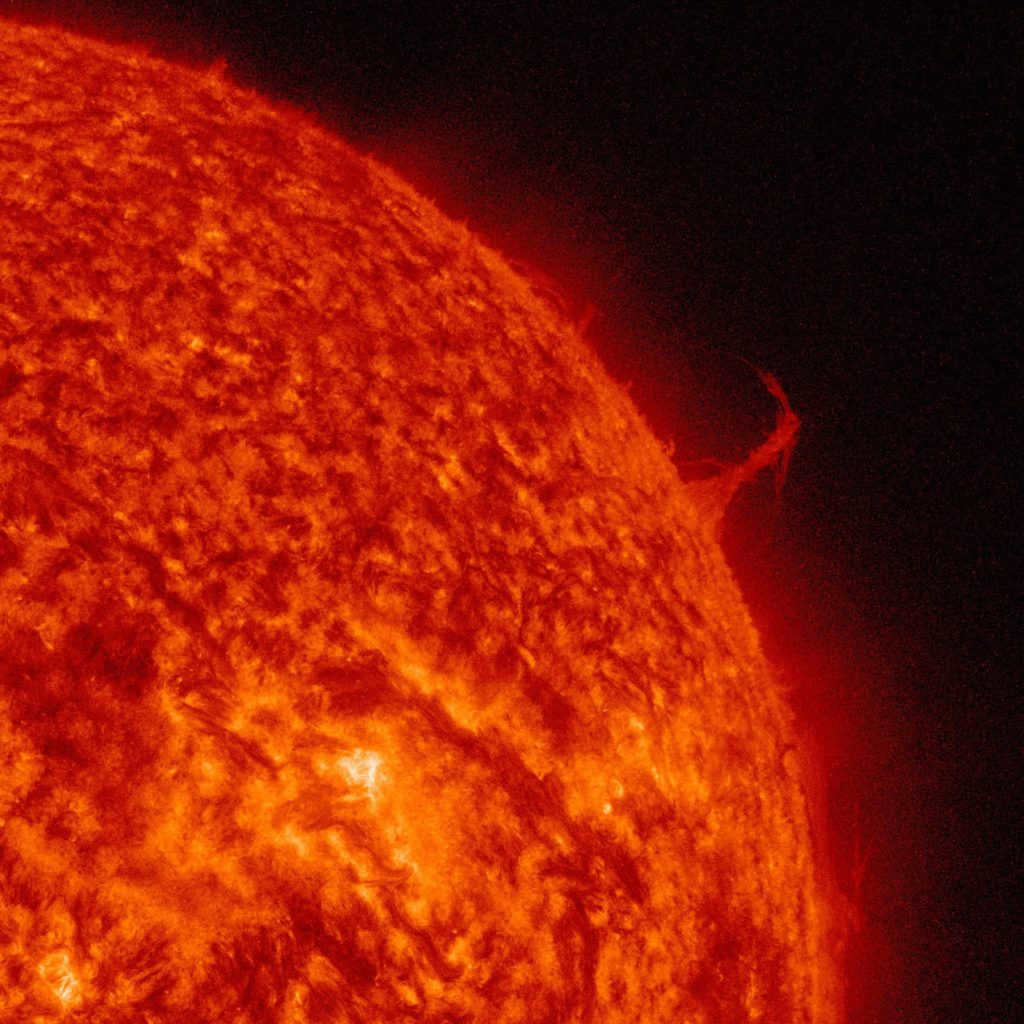
Magnetic Field
The Sun possesses its unique magnetic field. One can differentiate between a worldwide field and multiple localized fields.
Furthermore, diverse regions of the Sun exhibit local magnetic fields of varying intensity. The characteristics of these fields can differ greatly. It is infrequent for such a magnetic field to persist for more than 10 days. Local fields are commonly located in proximity to sunspots.
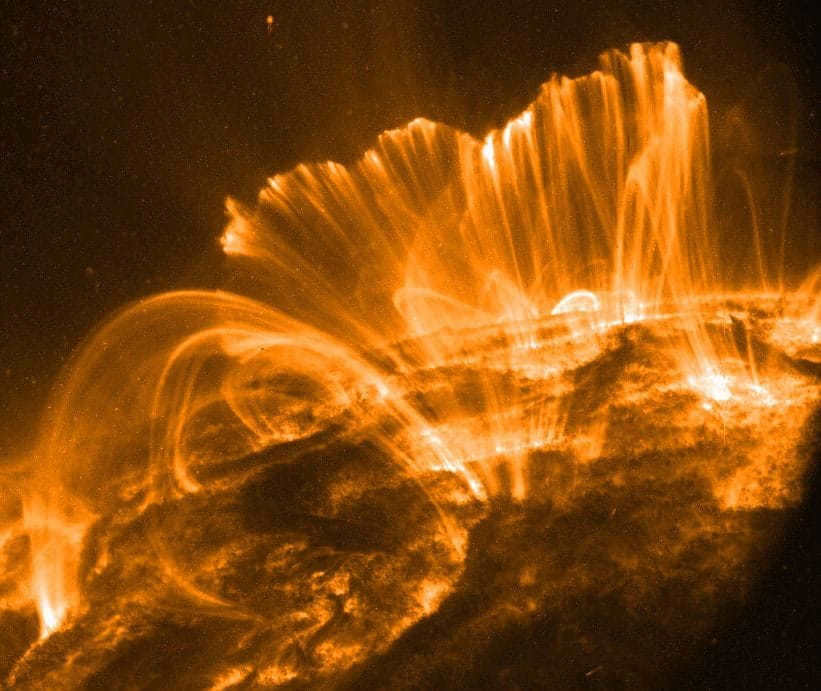
The Sun’s Journey through Time
The life cycle of the Sun has captivated generations of astronomers. Experts have estimated the Sun’s age to be around 4.5 billion years old. It originated from a vast cloud of gas and dust, gradually collapsing due to the pull of gravity. Our planet, along with all other celestial bodies in the solar system, formed from the same cloud. The increase in density and temperature resulted from this compression. When the temperature and pressure reached critical levels, thermonuclear reactions ignited. Thus, the Sun’s remarkable journey through time commenced.
The temperature of the star rises by 10 percent every 1.1 billion years, indicating that the previous temperatures on the planet were lower, and Venus may have had liquid water (the current temperature on Venus is hot enough to melt lead). As the Sun’s brightness increases in the coming years, it will also raise the temperature on Earth. Due to the excessive heat, the oceans will evaporate, water molecules will be carried away by motion and escape into outer space, breaking down into oxygen and hydrogen atoms, and ultimately leaving the Earth as a barren celestial body.
At some point in the future, helium will eventually run out. This depletion is estimated to occur in approximately 110 million years. As a consequence of pulsations, the outer layers of the Sun will gradually separate from its core. The core will then transform into a white dwarf, with a diameter similar to that of the current Earth. Remarkably, the mass of the core will only be half of what the Sun currently possesses.
The white dwarf will gradually cool down over time. Since there will be no nuclear reactions occurring within this object, it will take around 10 billion years for it to become a black dwarf, which will be the final state of the Sun.
The path and position of the Sun in the Milky Way Galaxy
Similar to the whole solar system, the Sun undergoes a circular motion around the core of the Milky Way. Situated at this core is a massive black hole. The solar system completes one revolution around this core approximately every 250 million years.
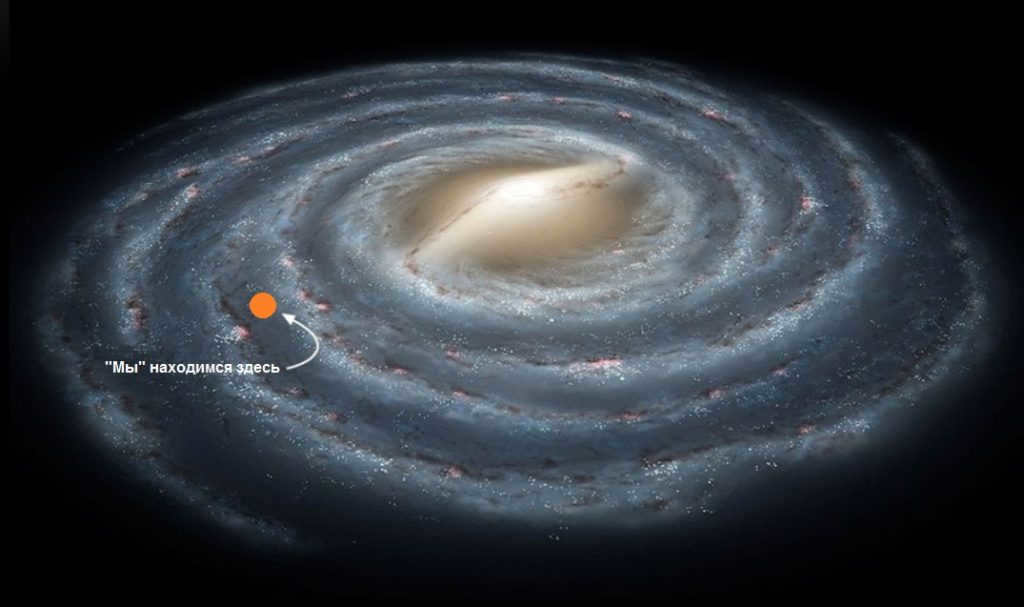
In the Orion arm, you can find the Sun and the solar system, as well as our galaxy. The rotation rate of the spiral arms is the same as the rotation rate of the galaxy, but it does not have any impact on the solar system. Interestingly, the spiral arms emit harmful rays that have the potential to annihilate all forms of life on Earth.
The flow of ionized particles that originates from the Sun is known as the solar wind. With speeds reaching up to 1200 kilometers per second, the solar wind permeates the entire space around the Sun. Composed of protons, electrons, and alpha particles, the solar wind is a fascinating phenomenon.
There are two types of solar wind: the slow wind and the fast wind. The slow wind moves at approximately 400 km/h and is heated to temperatures of around one and a half million degrees. Its composition closely resembles that of the solar corona. On the other hand, the fast wind moves at higher speeds, has a lower temperature, and is twice as dense as the slow wind.
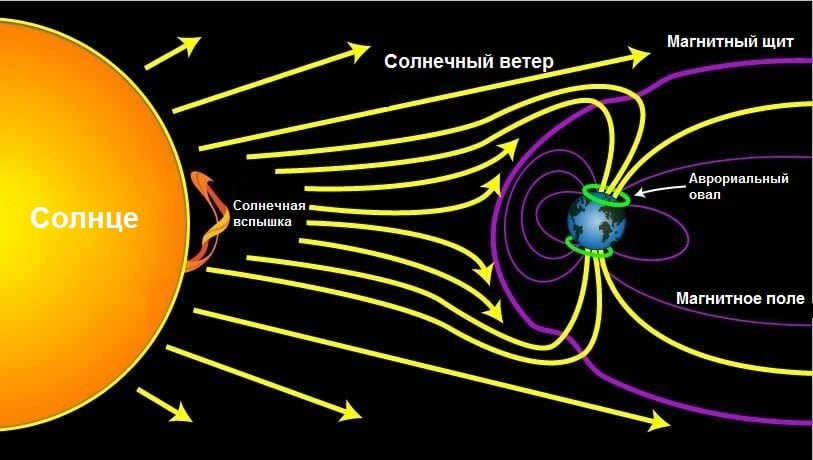
The Sun releases approximately 1.3⋅1036 particles every second, which are swept away by the solar wind. As a result, the star loses about 2⋅10-14 masses annually. Earth experiences regular natural phenomena such as magnetic storms and northern lights, which are caused by the propagation and disturbances of the solar wind.
Solar Cycles and Solar Activity
Solar activity refers to a range of phenomena that are linked to the development of strong magnetic fields. These phenomena are evident in the photosphere as sunspots. The presence of magnetic fields leads to the occurrence of flares, rapid particle flows, coronal emissions, disturbances in the solar wind, changes in electromagnetic radiation, and cosmic ray flows. On Earth, these magnetic fields can trigger magnetic storms and other related events.
The Wolf number serves as an indicator of the Sun’s activity level. It represents the number of sunspots visible from Earth. This number undergoes changes in an approximately 11-year cycle. Throughout the past 300 years, this cycle has exhibited a wider range of variability. Each cycle is assigned a consecutive number. The current 11-year cycle began in December 2019 and is projected to continue until 2030.
Scientists have also discovered a unique 22-year pattern in the Sun’s magnetic field. This cycle involves a complete change in the polarity of the magnetic field. Additionally, there is a larger century cycle that lasts between 70 to 100 years. Lastly, radiocarbon analysis has revealed a much longer 2300-year cycle.
Uncovering the Secrets of the Sun
Throughout history, mankind has held a fascination with the Sun. It has been revered as a deity and its mysteries have captivated scientists since ancient times. Even in the distant past, there were those who believed that the Sun was the center of our solar system, around which the planets revolved. This groundbreaking theory was later revived by Copernicus in the 16th century.
The first recorded observations of sunspots were made in China during the Han dynasty. It wasn’t until the 12th century, however, that the first drawings of these sunspots were created.
Spectroscopy was used to establish the composition of the Sun in the 19th century. In the 20th century, scientists discovered that the Sun’s energy comes from thermonuclear reactions. It was later discovered that these reactions also occur in all other stars. In the year 2020, the most precise images of our Sun, which is our source of light during the day, were captured.

The Solar System
We are aware that the Earth undergoes rotation on its axis, causing it to face the Sun and then turn away from it. This transition from day to night occurs. Additionally, we understand that the Earth orbits around the Sun. This journey takes a little over 365 days.
Rotation of the Sun
To us, it may seem as though the Sun remains motionless in space, appearing as a dazzling, stationary sphere surrounded by a group of planets. However, this perception is incorrect. The Sun is constantly in motion. The planets and their moons must exert considerable effort to keep pace with the Sun as it traverses through space.
Fascinating fact: If it were possible for us on Earth to measure the weight of the Sun, we would discover that its mass is equivalent to 41 followed by 55 zeroes tons. The Sun is predominantly composed of hydrogen and helium.
Firstly, the Sun undergoes rotation, similar to the Earth and other celestial bodies. Secondly, scientists hypothesize that the Sun experiences pulsations, resulting in fluctuations in its size. Lastly, the Sun navigates through interstellar space, while the planets revolve around it akin to how moths encircle a flickering candle flame.
The rotation of the Sun occurs due to the same fundamental principles that govern the planetary rotations. Similar to Earth and the other planets, the Sun originated from a swirling mass of interstellar gas and dust approximately 4.6 billion years ago. The solar system came into existence with inherent motion. However, unlike the Earth, the Sun is not a solid mass, but rather a luminous gas cloud. Consequently, its behavior differs from that of a solid planetary body.
The Sun’s rotation also influences various sections of its structure.
The time it takes for gases near the solar equator to complete one rotation is approximately 25 days. Meanwhile, at the poles of the Sun, the period of circulation for these gases is about 33 days. On the other hand, the Earth completes a full revolution around its axis in 24 hours. Amidst the many mysteries surrounding the Sun, one particularly intriguing phenomenon is the behavior of its super hot core. Scientists believe that the solar core rotates four times faster than the outer layers of the Sun.
The Sun’s pulsations

The Sun goes through a process of expansion and contraction, with a periodicity of five minutes, giving the impression that it is breathing. The reason behind this pulsation phenomenon is still unknown. One theory suggests that it is caused by sound waves passing through the solar gases.
However, there might be another form of pulsation occurring in the Sun. Scientists propose that gravity is responsible for a pulsation cycle that occurs every half an hour. This is due to dense gases from the solar core spreading into the less dense gases in the surface layers, causing a slight expansion of the Sun. Gravity then pulls these dense gases back towards the center, resulting in the Sun shrinking once again.
Fascinating video on the topic of the Sun
In case you come across any inaccuracies, kindly select the specific text and utilize the Ctrl+Enter shortcut.

Outer Space
The birth of life on Earth can be attributed to the celestial body above us. The Sun provides warmth and light to everything on the planet’s surface. It is no wonder that early civilizations worshipped the Sun as a majestic deity, as its significance to the primitive inhabitants of Earth was immense.
Throughout the centuries and millennia, the Sun’s importance in human existence has only grown. We are all descendants of this magnificent celestial entity.
The Sun, which is a star located in the Milky Way Galaxy, can be described as a massive, luminous sphere made of gas that continuously emits energy. It serves as the sole provider of light and heat in our solar system. Currently, the Sun is categorized as a yellow dwarf, based on the widely accepted classification of celestial bodies in the universe.
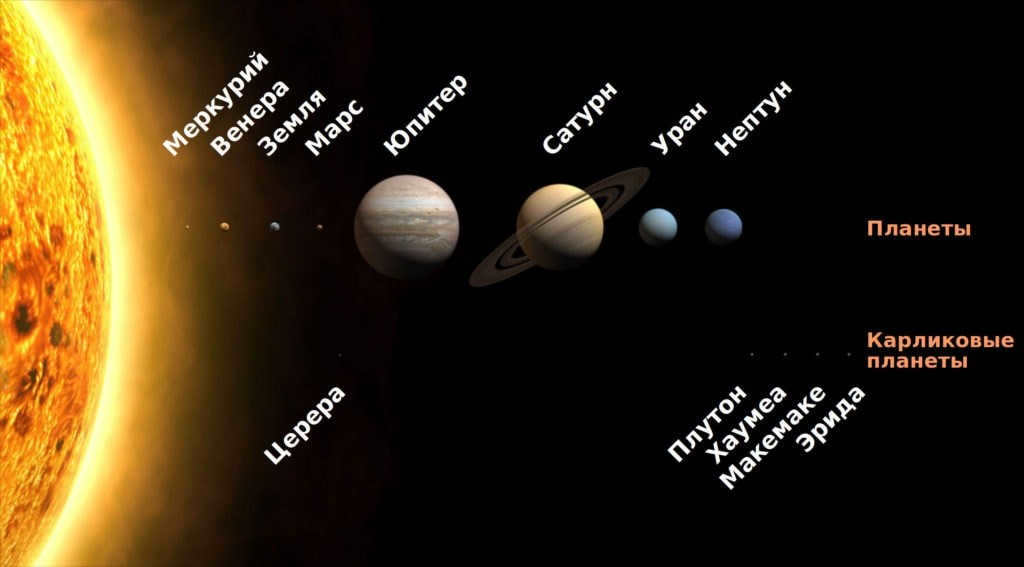
Sun’s Characteristics
The Sun possesses the following attributes:
- Age: 4.57 billion years;
- Distance from Earth: 149,600,000 km;
- Mass: 332,982 times that of Earth (1.9891 x 1030 kg);
- Average density: 1.41 g/cm3 (it increases by a factor of 100 from the periphery to the center);
- The Sun’s orbital velocity is 217 km/s;
- Rotational velocity: 1.997 km/s;
- Radius: 695,000-696,000 km;
- Temperature: ranging from 5,778 K at the surface to 15,700,000 K in the core;
- Corona temperature: approximately 1,500,000 K;
- The Sun has a stable brightness and is among the top 15% brightest stars in our Galaxy. It emits a lower amount of ultraviolet light compared to similar stars, but it has a greater mass.
Regarding its chemical composition, our star is not distinct from other stars and consists of: 74.5% hydrogen (by mass), 24.6% helium, and less than 1% other substances (such as nitrogen, oxygen, carbon, nickel, iron, silicon, chromium, magnesium, and other elements). Deep inside its core, continuous nuclear reactions occur, converting hydrogen into helium. The Sun accounts for the vast majority of the mass in the solar system, with 99.87% attributed to it.
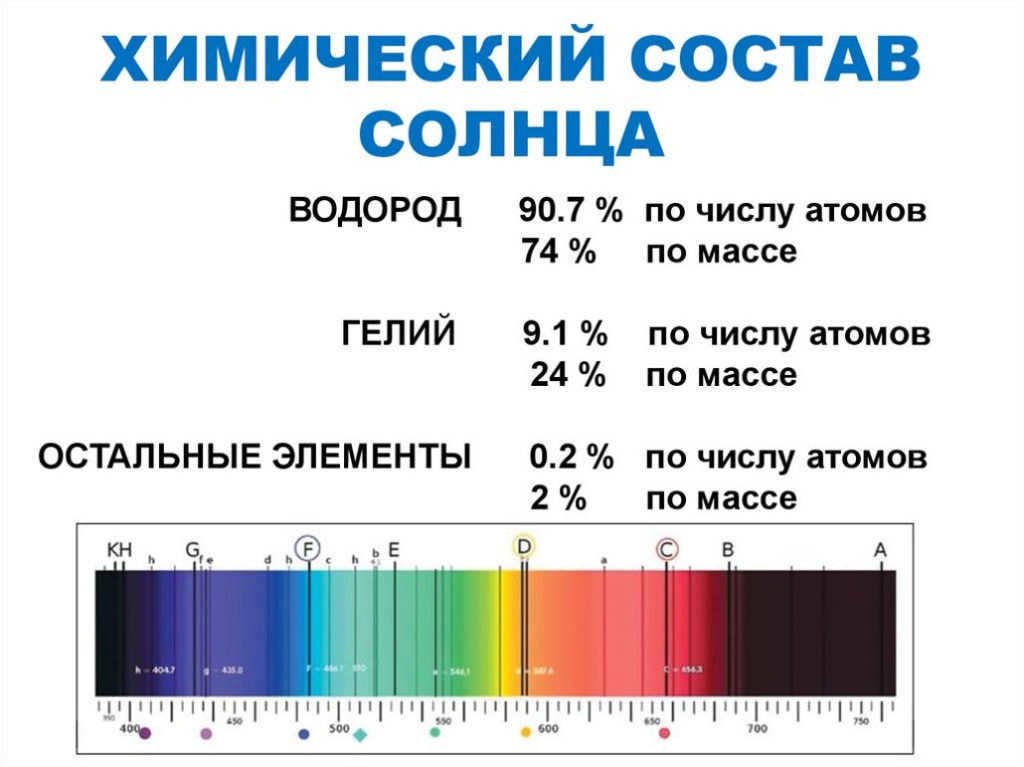
Fascinating trivia The Sun possesses an almost flawless spherical form. The variance in the diameters that connect the opposing points of the equator and the poles is a mere 10 kilometers. This is quite remarkable considering its immense magnitude!
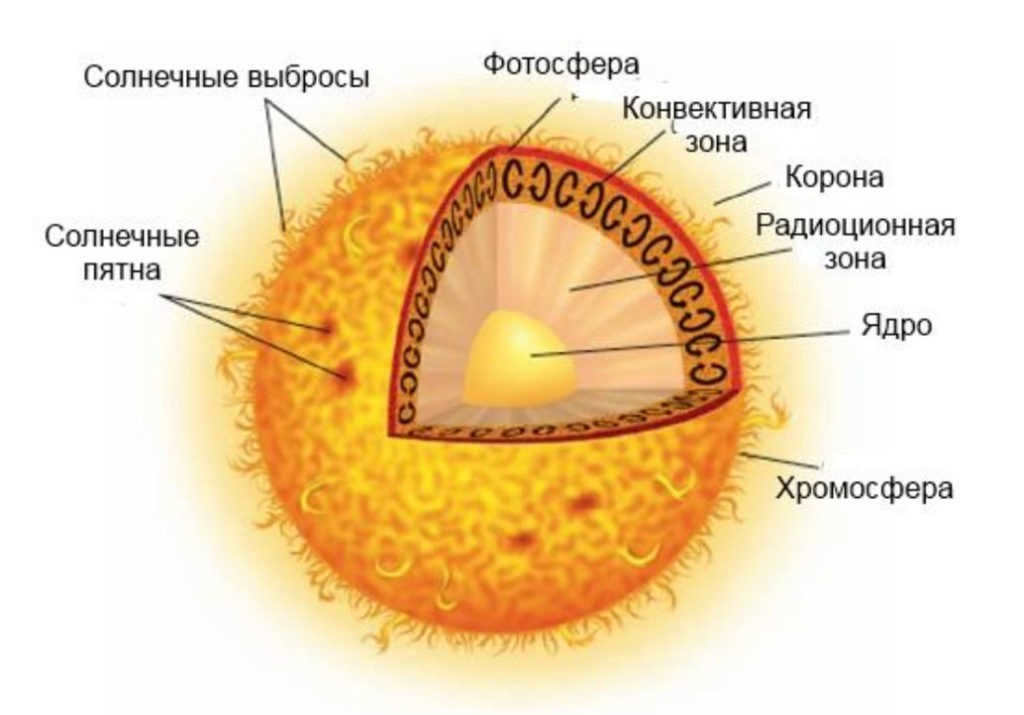
The core, located at the very center of our star, accounts for a quarter of the Sun’s radius. It is within this region that intense thermonuclear reactions take place, resulting in the emission of the radiation that we can see. The density of matter within the Sun is incredibly high, about 150 times denser than water, owing to its immense size.
Adjacent to the core is the zone of radiative transfer, where photons move in a chaotic manner. Interestingly, it takes an average of 170 thousand years for photons to reach the next layer.
The convective zone, situated in the outer region of the Sun, is characterized by the movement of plasma through the process of convection, where warm material rises and cools while colder material descends to be heated. Between these two regions lies a thin layer known as the tachocline, which is the birthplace of the Sun’s magnetic field.
The solar atmosphere is composed of three distinct layers: the chromosphere, the transition region, and the corona. The portion of the atmosphere that is visible to the naked eye, known as the photosphere, extends several hundred kilometers deep.
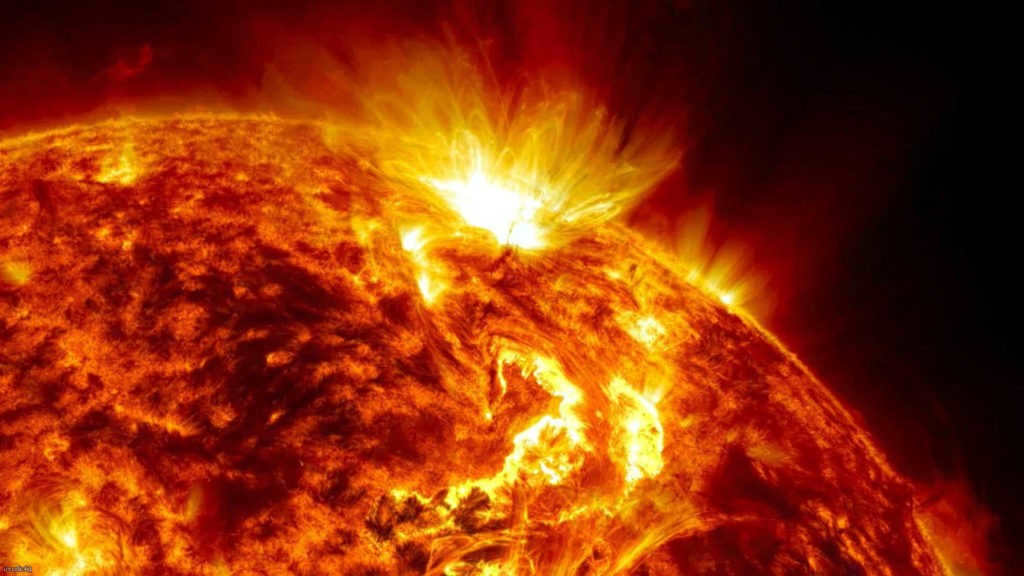
At a depth of 300 km, the temperature of the photosphere ranges from 8000 K to 4000 K in the upper layers. The rotation speed of the gas that makes up the photosphere is not uniform, with the equator rotating in 24 days and the poles in 30 days. The chromosphere appears red only during a total solar eclipse.
Sunspots, flares, and granules
The surface of the sun is not uniform in brightness and contains darker areas known as sunspots. These sunspots can persist for a few days to a few weeks and some can even be larger in diameter than the Earth.
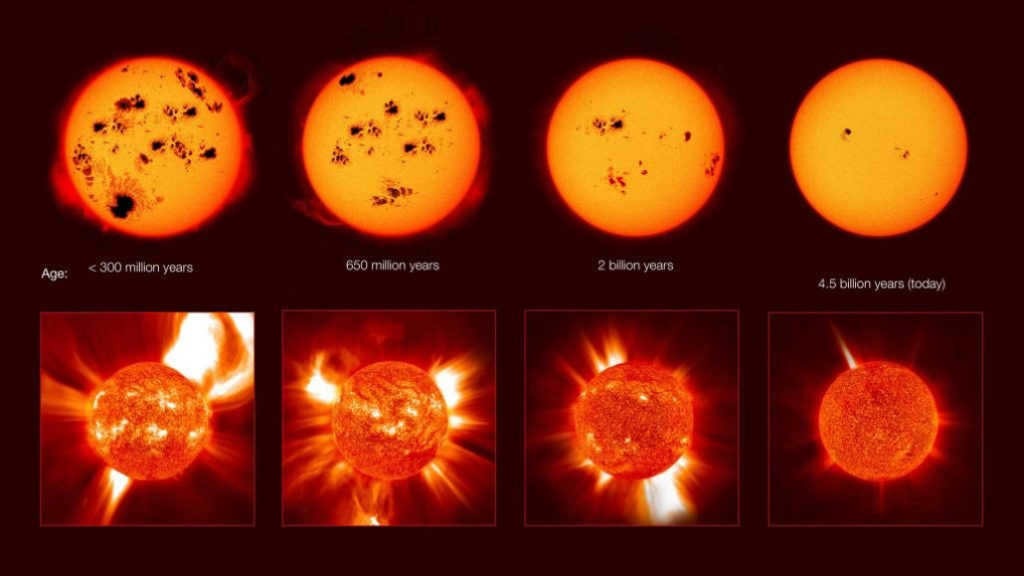
Fascinating fact: Sunspots are regions of intense solar activity that have a significant impact on our planet.
Moreover, the surface of the Sun is home to:
- Torches – areas of increased brightness that are like “siblings” to sunspots and often appear before or after them;
- Granules, which are about a thousand kilometers in size and cover the entire photosphere, making them visible to the naked eye;
- Supergranules, which are 35,000 kilometers in size and also cover the entire surface of the Sun. However, they only reveal themselves through physical effects.
Inside the Sun
As per the theory proposed by Hans Bethe, the Sun undergoes constant reactions where hydrogen is transformed into helium, resulting in a significant release of thermal energy. It can be compared to a hydrogen bomb that has been active for the past 5 billion years and is expected to continue for another 5 billion years.
A team of scientists from Durham University in the United Kingdom put forward a hypothesis three years ago suggesting that the Sun absorbs dark matter, which acts as an energy carrier within the star. To validate this hypothesis, research needs to be conducted using the largest gas pedal – the hadron collider. However, to proceed with this research, at least a particle of dark matter is required.
The solar wind
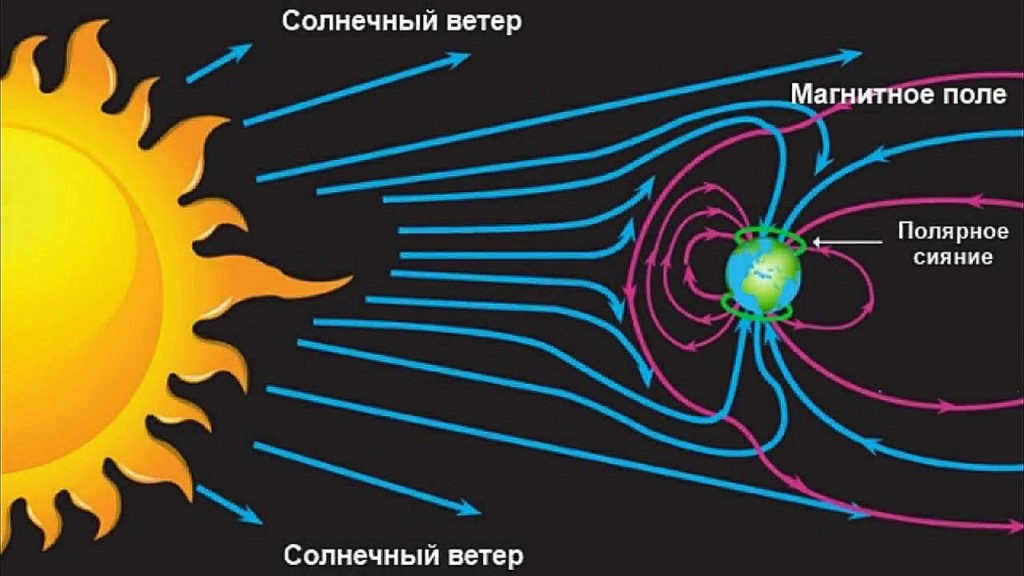
The solar wind is the movement of ionized particles from the Sun to the outer reaches of our solar system. This fascinating phenomenon occurs due to the difference in gravitational and pressure forces in the upper layers of the solar corona, which are unable to contain the flow of nuclear plasma within the star (other celestial bodies also have stellar winds). The velocity of the solar wind can reach up to 1200 km/sec, and the streams of particles permeate throughout space.
Did you know? Most of the objects in the Solar System orbit the Sun in a single plane (known as the ecliptic) and in the same direction as the rotation of the star itself.
The person who first observed this phenomenon was Eugene Parker, an astrophysicist from the United States. However, prior to his discovery, several scientists had speculated about the emission of charged particles from the surface of celestial bodies. One such scientist, Ludwig Biermann from Germany, made a fascinating observation about the tails of comets. He noticed that these tails always pointed away from the Sun, suggesting that they were being influenced by some sort of physical force.
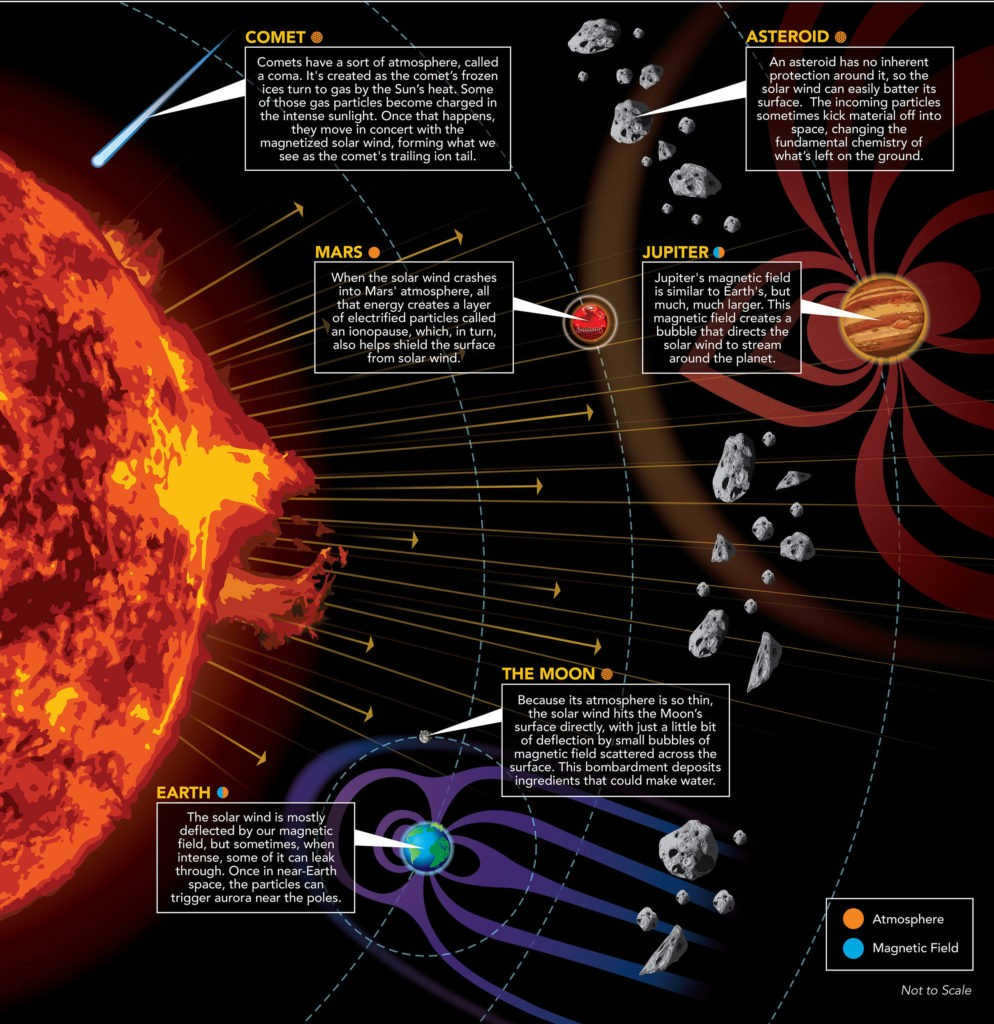
As the era of space exploration dawned, Parker’s theory was validated. Solar wind streams were observed from the spacecrafts: “Luna 1, Mariner 2. Furthermore, a groundbreaking experiment involving four satellites was conducted to gauge the intensity of the shockwave resulting from the collision between the solar wind and the planet’s magnetosphere. This endeavor yielded invaluable scientific information with exceptional precision of measurements.
What is the reason for the Sun’s brightness?
Throughout history, numerous philosophers and scientists have attempted to provide an explanation for the Sun’s radiance. Anaxagoras, an ancient Greek astronomer, even faced imprisonment due to his hypothesis about a luminous metal sphere. However, the true understanding of this phenomenon began to emerge in the early 20th century with the discovery of radioactivity and the subsequent exploration of controlled nuclear and thermonuclear reactions.
These groundbreaking discoveries unraveled the mystery surrounding the origin of this ubiquitous natural occurrence. British scientists Ernest Rutherford and Arthur Eddington were among the pioneers who proposed that the Sun undergoes thermonuclear fusion reactions deep within its core. As a result, the Sun’s hydrogen gradually transforms into helium, emitting streams of photons that we perceive as light.

Did you know? The sun appears to be yellow, red, or orange due to the layers of the Earth’s atmosphere that the light passes through, but in reality, its color is pure white.
Solar eclipse
The occurrence of a solar eclipse has always evoked a range of emotions in uninformed individuals, leading to feelings of horror and panic. There have been individuals who sought to exploit the event for personal gain, hoping to establish themselves as fortune tellers or clairvoyants. However, it is not only humans who react to the presence of darkness during an eclipse, but animals as well. Although, for the most part, they simply perceive it as the onset of night.
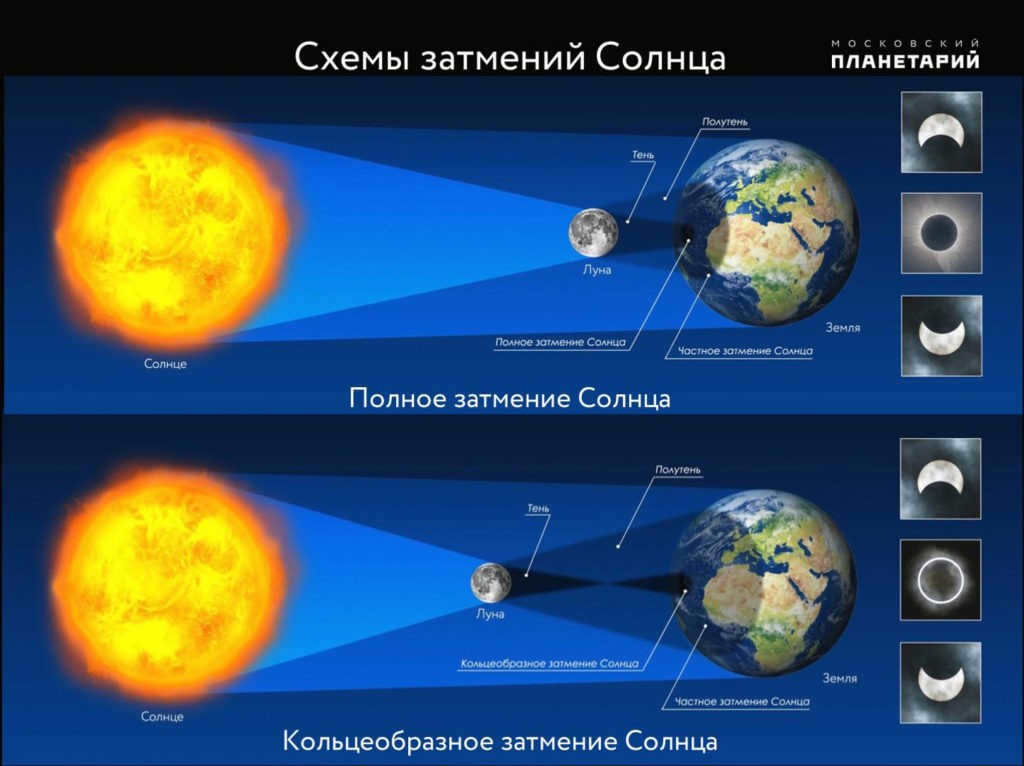
The phenomenon can be explained scientifically: the Sun is covered by the Moon. This occurs only during a new moon when all three celestial objects are approximately aligned, although not always. Solar eclipses can be classified based on the perspective of an observer on Earth:
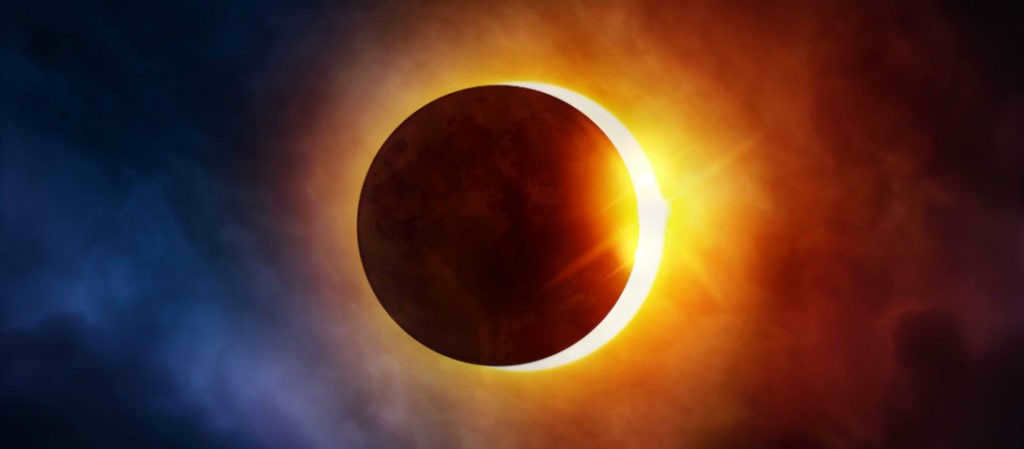
- The satellite covers the luminary partially in the “Private” eclipse.
- The solar disk is completely closed in the “Total” eclipse.
- The cone of the cast shadow does not reach the Earth’s surface in the “Annular” eclipse.
- Two observers in different points simultaneously see one of the types of solar eclipses in the “Total annular” or “hybrid” eclipse.
By observing this phenomenon, scientists have made several significant discoveries and gained insight into the Sun’s corona and atmosphere, which is typically challenging to observe under normal conditions. Additionally, the rarity of this event adds to its appeal, as it only occurs 237 times per century.
There are various theories surrounding the birth of the Sun. Among the most widely accepted is the idea that it emerged from a gas and dust cloud formed by the aftermath of a supernova. To support this claim, proponents point to the significant quantities of uranium and gold found within the central body of our solar system.
Fascinating trivia: The Sun’s radius is 2100 times smaller than that of UY Shield, the largest star ever discovered in the entire universe.
Yet another theory postulates a series of metamorphoses: a comet originating from the outskirts of the Galaxy -> freezing planet -> colossal planet -> infrared dwarf -> yellow dwarf. As the Sun gathered mass, gravitational forces caused the core’s density to reach the point of triggering thermonuclear reactions, as well as the ability to retain an atmosphere. Moreover, the immense gravitational pull prevented even light gases such as hydrogen and helium from escaping into the depths of outer space. Nevertheless, some of these gases still manage to break free from the surface of the star.
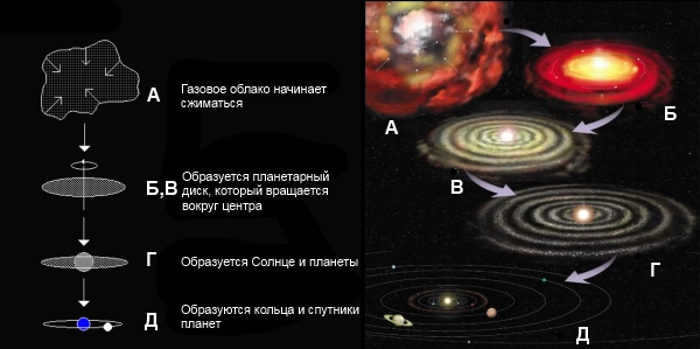
There are several celestial bodies similar to the Sun in various constellations, including Gemini, Scorpius, Canes Venatici, Corona, and Draco. These stars share similarities in terms of their luminosity, temperature, mass, density, and estimated age, making them comparable to our own star.
Fascinating fact: The Sun’s future trajectory involves eventually expanding and engulfing the Earth as a red giant, before eventually shrinking into a white dwarf of its own size.
It seems that the Sun’s appearance is attributed to protostars from earlier generations, as it consists of a considerable quantity of metals. Its age is estimated to be around 4.5 – 4.75 billion years, and throughout this entire period, it has been steadily intensifying in both brightness and temperature (ignition).
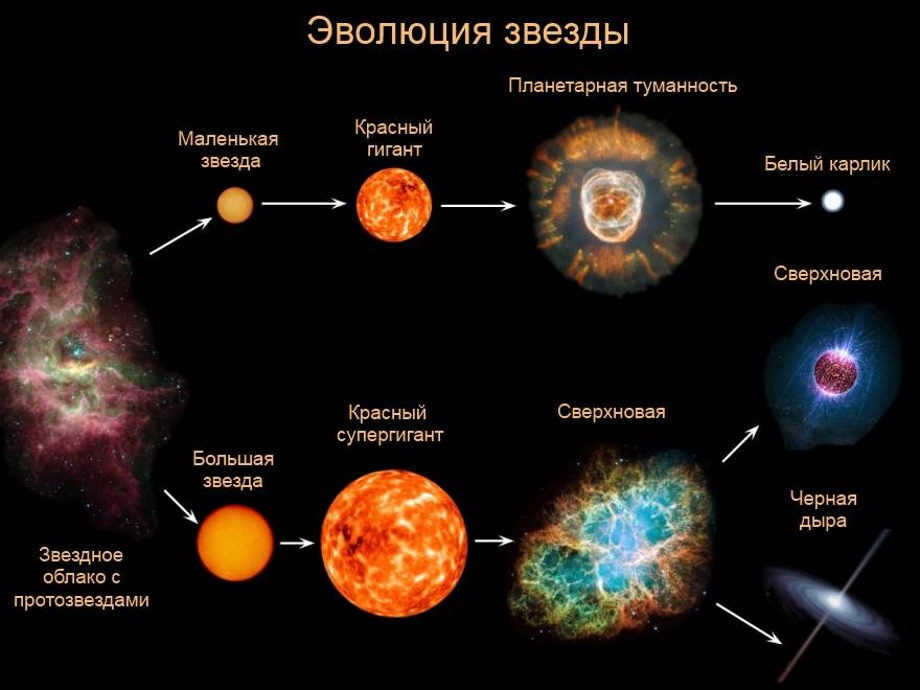
Did you know? The magnetic field of our star has a duration of approximately 22 Earth years, equivalent to two periods of solar activity lasting 11 years each.
The luminary cannot undergo such a physical process without undergoing a loss of hydrogen mass, which is the primary component of its composition. Eventually, the hydrogen will deplete and escape, causing the luminary to start contracting as the helium takes over. As a result, the size of the Sun will expand until it reaches the boundaries of the Earth’s orbit. It will then transform into a red giant and remain in this state for an estimated 120 million years. Subsequently, a nebula will emerge due to a significant reduction in mass and a substantial expansion of the outer layer. Eventually, the red giant will evolve into a white dwarf, which will eventually turn black over trillions of years.
The Position of the Sun within the Milky Way Galaxy
We are incredibly fortunate as our solar system finds itself situated within the habitable region of the Milky Way galaxy, which provides favorable conditions for the development of life. Our galaxy is composed of four primary spiral arms, and the Sun is currently positioned on the outskirts of one of these arms known as the Orion arm.
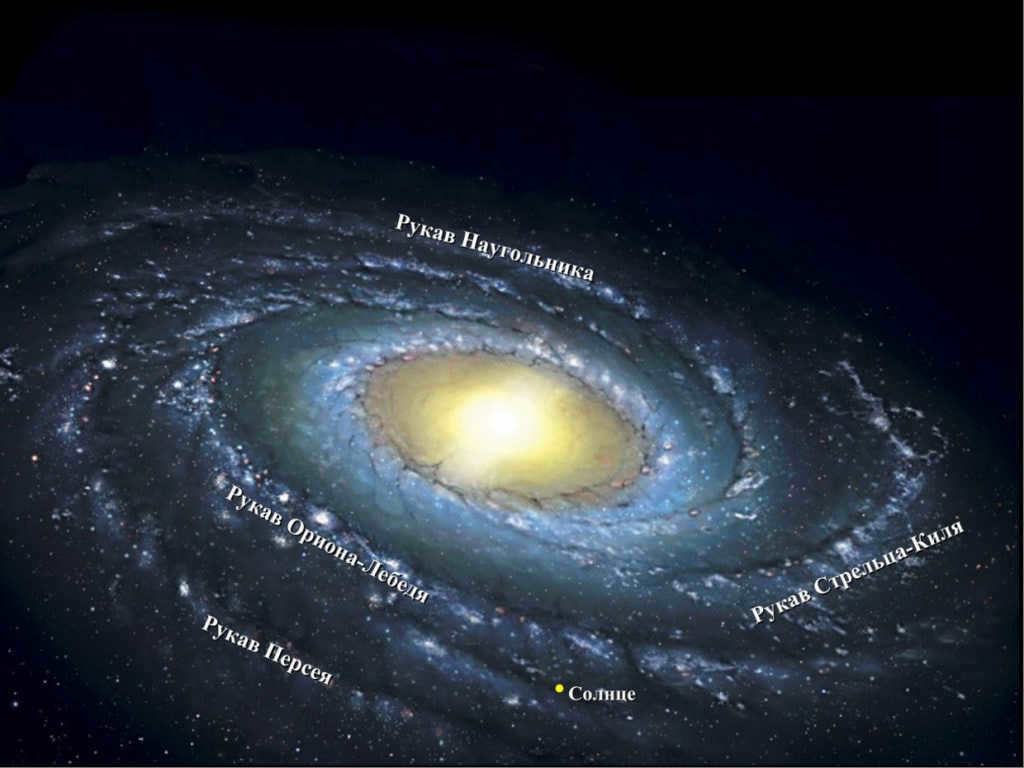
The movement of our galaxy, known as the solar system, within the Milky Way is a fascinating phenomenon.
Located on the outskirts of the galaxy, the solar system is approximately 8 thousand parsecs away from its center (1 parsec equals 3.2 light years). This significant distance plays a crucial role in ensuring the tranquility and stability of our cosmic neighborhood, as it protects us from potential galactic cataclysms.
Thanks to the dedicated research of two remarkable astronomers, namely William Herschel and Harlow Shapley, valuable insights into the dynamics of our galaxy have been uncovered. Shapley, in particular, was able to construct an intricate map of the Milky Way, shedding light on the intricate movements of celestial bodies within it.
One of the most astonishing discoveries is the revelation that the solar system rotates around the galactic center at an astonishing speed of over 200 km/s. Remarkably, it has completed approximately 30 revolutions around the center during its impressive 4.5 billion-year existence.
The Sun and the Earth
The impact of the sun on our planet is immeasurable. This is not an overstatement. The Earth orbits around the Sun, as if presenting its different faces, resulting in the changing of seasons and the cycle of day and night.
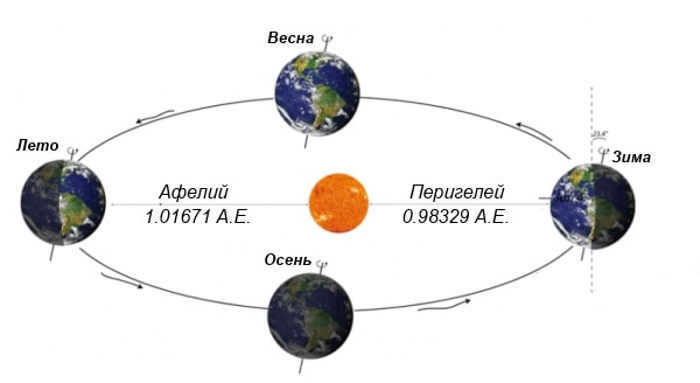

In addition, the Sun’s emission of heat and light has given rise to and sustains life in all its various forms. Each year, every square kilometer of the Earth’s surface receives 342 watts of energy, completely free of charge. By simply looking at the electricity bill and multiplying this value by the number of hours in a year, it is immediately evident how abundant we are.
However, this represents only a fraction of the immense wealth bestowed upon our planet by the Sun. It is thanks to its rays that plants continue to grow, the atmosphere becomes saturated with the essential oxygen needed for respiration, the environment is constantly disinfected, and the human body is able to heal and recover.
We have discovered how to harness the planet’s resources to generate electricity, a process that is fueled by the Sun. With this knowledge, we can confidently say that humanity will continue to advance and reach new heights for billions of years by harnessing the power of the Sun.
The Sun in ancient mythology
In ancient times, cultures around the world worshipped and revered the Sun, seeing it as a radiant golden disk that provided light and warmth. Countless sacrifices were made and prayers were dedicated to this celestial body, which was held in high esteem and praised for its power.
Fascinating fact: Japan is often referred to as the “Land of the Rising Sun.” The phrase “The empire over which the sun never sets” was used to describe the vast colonial empires of Spain and Britain.
The sun has been a significant figure in mythology, with ancient kings and rulers believed to have descended from the sun. In addition, ancient civilizations held a deep fear and terror of the sun, fearing its anger and potential extinction. In America, sacrifices were made to appease the sun as the supreme deity, while the Greeks had their own cosmogonic legend of Phaeton.
Even in modern times, remnants of these fears persist. News of an explosion or unusual growth in sunspots can trigger anxiety and unease. Such fears often find fertile ground in the minds of uninformed individuals with strong superstitions.
If you come across any errors, please highlight the text and press Ctrl+Enter.
The sun is vital for the existence of life on our planet. This celestial body not only provides us with warmth and light, but also serves as a guide for navigation. By observing the sun’s position in the sky, we can easily determine the cardinal directions and find our way. Additionally, the sun brings joy and vitality to all living beings on Earth, making it an essential source of energy and life.
The path of the sun
Every morning, the gentle sun beckons us to wake up and embark on new adventures in this marvelous world. And as the sun slowly traverses the sky throughout the day, it gradually disappears beyond the horizon, offering us a chance to unwind and recharge after a day filled with hustle and bustle. But where does this journey commence? And where does the sun ultimately set at the culmination of its voyage?
The ascent of the primary celestial body commences in the east. At the close of the day, the sun bids us farewell in the west. It then continues its expedition, albeit on the opposite side of our remarkable planet. And when morning arrives, it resurfaces once again in the east. Such is the spectacle as observed from our vantage point on Earth. It is intriguing to note that ancient civilizations held a different perspective on this matter. In light of this, where precisely does the sun truly set, and how does it reemerge in the heavens?
If we don’t delve into the intricacies of the ancient worldview, we can agree with their perspective. The reality is that our planet is a constituent of the solar system, with the Sun positioned as a stationary entity at its center. Meanwhile, the Earth orbits around the Sun and, in addition to this motion, it also rotates on its imaginary axis. In a span of 24 hours, or a day, the planet completes a full rotation. This is why it appears to us that the locations where the sun sets and rises remain constant.
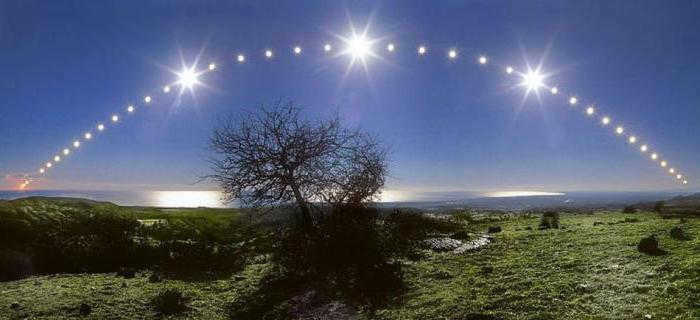
Space Perspective
If one were to observe the solar system from a distant vantage point in outer space (to gain a comprehensive view of all the planets), the panorama would be as follows: all the celestial bodies in this system revolve in the same direction, from west to east (counterclockwise). However, Venus spins on its axis in the opposite direction compared to the other planets. Astronomers speculate that this unique rotation could be attributed to a colossal asteroid impact that occurred in the distant past, altering its rotational trajectory. Similarly, Uranus appears to have been affected by similar cosmic forces, resulting in an apparent “upside-down” rotation. Consequently, when observing Uranus, the rotation appears to be viewed from a sidelong perspective.
If a person were to observe the movement of the primary celestial body from the North Pole, they would witness the anticlockwise rotation of the Earth, as well as the exact location where the sun sets and how it rises. Visually, the motion of the celestial object will seem to be from west to east. However, in reality, it will be moving towards the east, while the Earth itself rotates on its axis.
Interestingly, the sunrise does not occur simultaneously in various regions across the globe. For instance, on the eastern coast of the United States, it happens approximately three hours earlier than in the areas along the western coast. Consequently, the time of sunset also varies across different parts of the world.

Twilight
The period of time immediately preceding sunrise and sunset is known as twilight. It is a particularly enchanting sight. The celestial body’s disk is positioned very close to the horizon, allowing some of its rays to penetrate the upper layers of the atmosphere and reflect off the Earth’s surface. This colorful spectacle typically lasts for about two hours, although in temperate latitudes, the duration may vary. In circumpolar zones, twilight can last for several hours before sunset, and at the poles, this period can last from two to three weeks! Conversely, at the equator, twilight only lasts for approximately 20-25 minutes before sunrise.
At this period, due to the optical phenomenon, we witness a breathtaking spectacle as the sun’s beams light up the Earth’s surface and the sky with an array of hues.

Orienteering: How can I find my way without a compass?
If you possess a wristwatch with hands (not electronic), you can determine the directions by positioning them “horizontally” and rotating them clockwise towards the sun. By mentally drawing a line that bisects the number 12 and points towards the celestial luminary, you can establish a north-south line. It is also worth noting that before noon, the sun will be to the left of south.
Having an understanding of how to find your way without a compass is crucial for orienting yourself in any location and traveling in the correct direction. This knowledge is particularly valuable for tourists, forestry workers, hunters, sailors, and individuals involved in other outdoor activities.

It’s crucial to keep in mind the direction of the sunrise and sunset in the middle latitudes. In these areas, the primary celestial body rises in the northeast and sets in the northwest during the summer months. In winter, it rises in the southeast and sets in the southwest. The only two occasions when the sunrise and sunset align perfectly in the east and west, respectively, are the equinoxes on March 21 and September 23.
Shadow and Navigation on the Terrain
There is an alternative method for orienting oneself using shadows. In unfamiliar environments, when the need arises, it is important to consider the different celestial bodies. This could include the North Star at night and the sun during the day.
By understanding the direction in which the sun sets, one can determine the other cardinal directions and choose the correct travel route. For instance, in higher latitudes, during the summer nights, the sun sets close to the horizon. As a result, the sky appears brighter on the northern side compared to the southern side.






